Bakchar honeysuckle - characteristics, description, productivity
Honeysuckle Bakcharskaya is the general name of varieties bred at the Bakcharskoye horticultural enterprise in the Tomsk region. Unique planting material with high adaptation abilities to harsh climates and resistance to diseases and insects is grown here. We have prepared a description the best varieties of honeysuckle: Jubilee, Bakcharsky giant, Pride of Bakchar, Tomichka, Yugan, Morena, Delight, Silginka.
Description of Bakchar honeysuckle
Honeysuckle Beauty Bakcharskaya, or Turchaninka, is a mid-early variety, obtained from the Siberian Research Institute of Horticulture named after. M. A. Lisavenko. The work used seedlings of honeysuckle Turchaninov No. 15/63 - an elite form, free from pollination, bred at the Far Eastern Experimental Station VNIIR named after. N. I. Vavilova. Honeysuckle Bakcharskaya belongs to the Turchaninov honeysuckle species. Authorship belongs to I.K. Gidyuk and Z.I. Luchnik.
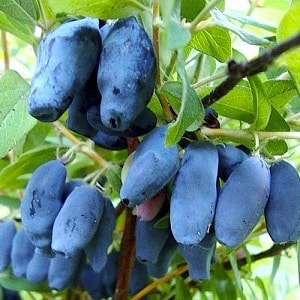 The culture was included in the State Register of Russia in 1987 with permission to grow in open ground in the following regions:
The culture was included in the State Register of Russia in 1987 with permission to grow in open ground in the following regions:
- West Siberian - Altai Territory, Kemerovo, Tomsk regions;
- East Siberian - Republic of Khakassia and Krasnoyarsk Territory.
Bushes are medium dense, semi-spreading. Young shoots are anthocyanin colored. The shedding of the crop is weak.
The fruits have a drop-shaped, elongated shape with slight tubercles on the surface. The skin has a dense structure, is colored blue, and is abundantly covered with a waxy coating.
The pulp is tender, sweet and sour in taste, with a pleasant bitterness and a weak aroma.. 100 g of fruit contains 27.2 mg of vitamin C and 510 mg of P-active substances. The tasting taste score is high - 4.2 points.
The average yield per bush is 1.5-3.8 kg per year. The variety is a fast-growing crop and is suitable for mechanized harvesting. Honeysuckle Bakcharskaya is self-sterile and requires additional pollination.
To get a rich harvest It is recommended to plant nearby several different varieties. The best pollinators are: Strezhevchanka, Daughter of the Giant, Silginka, Yugana, Bakcharsky giant. The Bakcharskaya honeysuckle variety is resistant to frosts down to -50°C, fungal infections and insects.
Reference. The variety is sometimes called Bogucharskaya or Bakhchisarayskaya honeysuckle due to the similarity of the names. However, Bogucharskaya honeysuckle is a separate early-ripening variety, bred in 1982 in the Moscow region, and Bakhchisarai honeysuckle does not exist.
The best varieties
The most popular varieties are considered: Jubilee, Bakcharsky giant, Pride of Bakchar, Tomichka, Yugan, Morena, Delight, Silginka.
Anniversary
Breeders from the Bakcharsky stronghold of northern gardening in Tomsk worked on the creation of the Bakcharskaya Yubileinaya honeysuckle variety. Now this enterprise is called the Federal State Unitary Enterprise “Bakcharskoe”. Honeysuckle Yubileynaya continues the so-called “Kamchatka line”. The variety was included in the State Register of Russia in 2013. It is popularly known as honeysuckle Jubilee Bakchar.
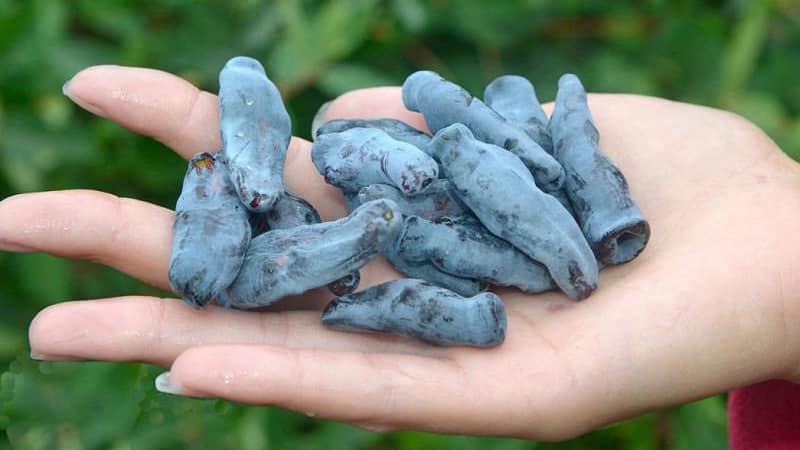
Distinctive characteristics of the variety:
- bushes are wide (1.2 m), rounded, medium-sized - up to 1.6 m tall;
- branches are strong, straight, red-brown without edge;
- the leaf blade is elongated, dark green, matte, slightly pubescent, dense;
- flowers are small, pale yellow;
- flowering period - early May;
- fruit ripening period - end of June;
- the beginning of fruiting - 3 years after planting;
- Fruit ripening is extended;
- the fruits are large, elongated oval, weighing 1.5 g;
- the taste is pleasant, sweet and sour, with a slightly perceptible bitterness;
- tasting taste score - 4.3 points;
- yield - 3-4 kg per bush;
- high transportability;
- the best pollinating varieties: In Memory of Gidzyuk, Amphora, Azure, Pride of Bakchar, Nymph.
Interesting things on the site:
Where to plant honeysuckle: criteria for choosing a place
Planting and caring for honeysuckle in the open ground in spring
Bakchar giant
Bakchar giant is a large-fruited variety of medium-early ripening. The culture was brought out by employees of the Federal State Unitary Enterprise "Bakcharskoye". Authorship belongs to N.V. Savinkova, I.K. Gidyuk, A.P. Pavlov.
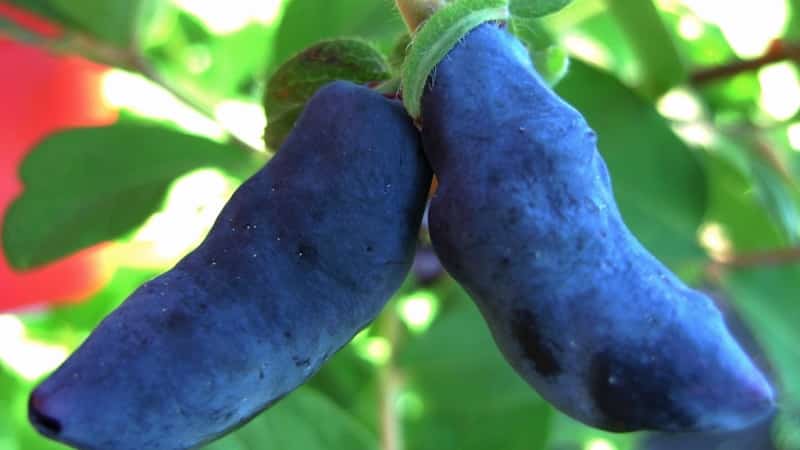
Distinctive characteristics of the variety:
- vigorous bushes - 1.7-1.9 m in height, 1.3 m in width;
- the crown is oval, spreading, loose, which greatly facilitates harvesting;
- branches are straight and thick;
- young shoots are light green without anthocyanin coloring, length - 0.6 m;
- leaves are large, pubescent, matte, dark gray-green in color;
- the fruits are large, weighing 1.8-2.5 g, length - 4-5 cm, diameter 1.2 cm, asymmetrical shape, elongated oval, slightly lumpy surface;
- skin of medium density, dark blue color with a waxy coating;
- the pulp is tender, dessert, sweet and sour;
- tasting taste score - 4.8 points;
- ripening period - end of June;
- the beginning of fruiting - 2-3 years after planting;
- yield -1.7-4.5 kg per bush;
- high transportability;
- the best pollinating varieties: In Memory of Gidzyuk, Amphora, Azure, Pride of Bakchar, Nymph.
Pride of Bakchar
Pride of Bakchar is a variety bred in the Bakcharskoye nursery. Included in the State Register of Russia in 2006.
Reference. Honeysuckle Pride of Bakchar bears fruit for 30 years after planting.
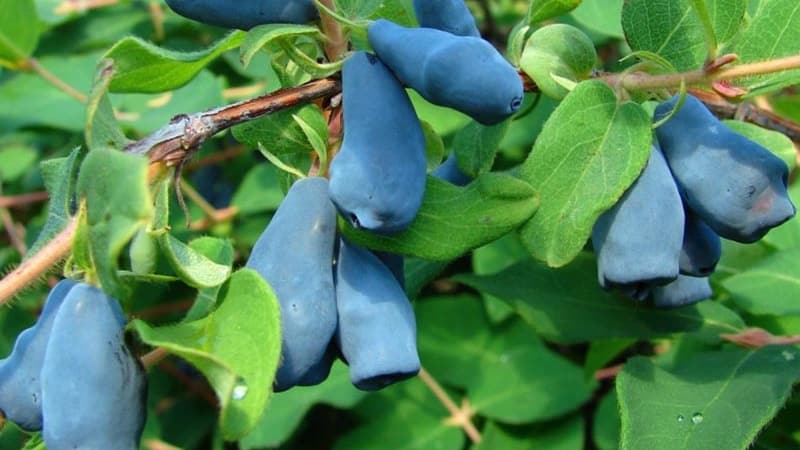
Characteristics of culture:
- bushes are medium-sized, spreading, wide, up to 1.6 m high, 1.5 m wide;
- young shoots are long, light, lowered to the ground, pubescent;
- leaves are medium-sized, matte, dark green in color, slightly pubescent;
- the berries are large, 5.5 cm long, 1.5 cm in diameter, weighing 2-3 g;
- the skin is dense, violet-blue, with a white coating;
- the flesh is tender;
- the taste is sweet and sour, with a slight bitterness;
- tasting taste score - 4.3 points;
- fruit ripening - in the second half of July;
- ripe berries fall off quickly and require timely picking;
- yield 3-4 kg per bush;
- high transportability;
- pollinating varieties: Amphora, Lazurnaya, Pride of Bakchar.
Tomsk
Tomichka variety was withdrawn under the leadership of the plantation workers of the Bakchar stronghold of the NIISS named after. M. A. Lisavenko - I. K. Gidzyuka and Z. I. Luchnik. The variety was included in the State Register of the Russian Federation in 1987.
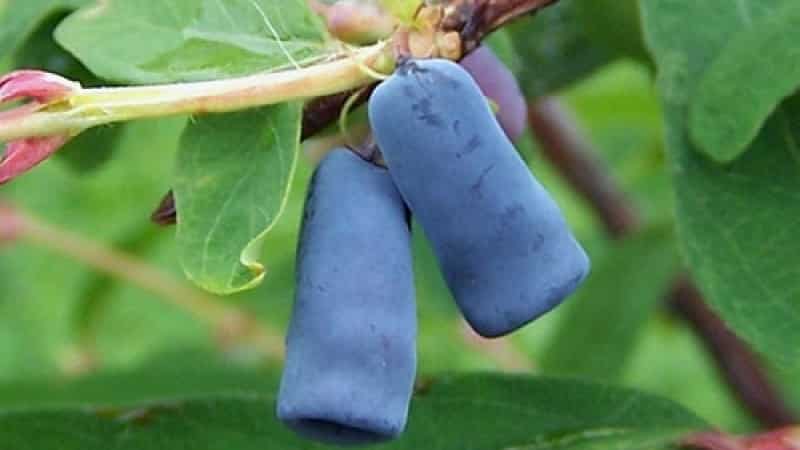
Characteristics of culture:
- medium-sized bushes - 1.6-1.7 m, spreading at the base, lower branches drooping;
- plastic sheets of medium size, oval with a pointed tip, light green or green in color;
- flowers are small, pale green;
- fruits are cylindrical, teardrop-shaped or pitcher-shaped, with a flattened, slightly depressed top;
- berry length 2.3-2.5 cm, weight 2-5 g;
- the skin is thin, dark purple, with a waxy-smoky coating, the surface is bumpy;
- ripening period - mid-June;
- the pulp is tender, juicy, the taste is pleasant, sweet and sour;
- ripe berries fall off quickly and need to be collected in a timely manner;
- yield -2-2.5 kg per bush;
- the beginning of fruiting - 4 years after planting;
- transportability is average;
- pollinators: Amphora, Pride of Bakchar, Azure.
Yugana
The Yugan honeysuckle variety was bred in 2010 in the Bakchar Federal State Unitary Enterprise based on the Kamchatskaya and Turchaninova honeysuckle varieties. It is being tested, so it is not yet included in the State Register.
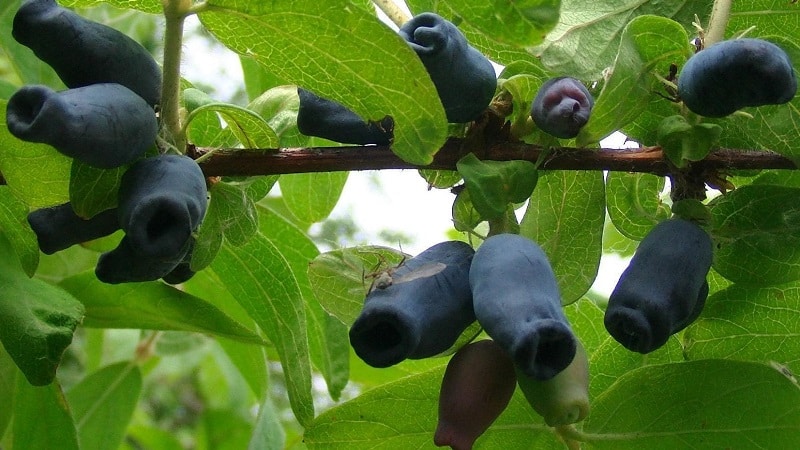
Characteristics of the variety:
- bushes are medium-sized, semicircular, 1.5 m high, 1.9 m wide;
- young shoots are covered with bristly hairs and have a green color without anthocyanin;
- the fruits are pitcher-shaped, the top is often thickened, less often oval with a rounded tip;
- fruit weight 1.4-1.8 g, length 1.2-1.4 cm;
- the skin is dense, dark purple;
- dessert taste, sweet and sour;
- tasting score – 4.9 points;
- yield - 3.5-6 kg per bush;
- ripening period - mid-June;
- the beginning of fruiting - 3-4 years after planting;
- manual collection is recommended 2 times a season;
- transportability is excellent;
- winter hardiness is high - up to -50°C;
- pollinating varieties: Bakcharsky giant, Strezhevchanka, Vostorg.
Moraine
Morena is an early ripening variety, bred in St. Petersburg at the Pavlovsk experimental station VIR named after. N. I. Vavilova. Elite forms No. 101 and No. 21-5 were used for crossing. The authors of the selection are M. N. Plekhanova and A. V. Kondrikova. The variety was included in the State Register of Russia in 1995. Other titles are No. 689-42 and The Little Mermaid. The variety is recommended for cultivation in the North-West region.
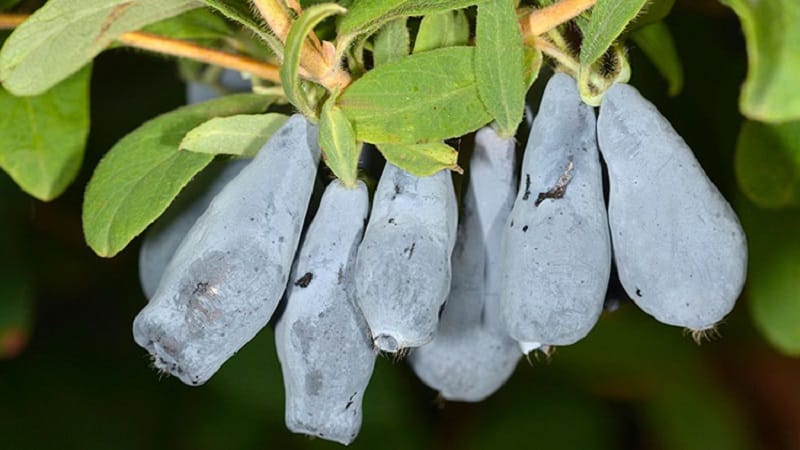
Characteristics of culture:
- bushes are medium-sized, wide, 1.7 m high, 1.7 m wide;
- the crown is neat, squat, oval, not prone to thickening;
- the leaf blade is large, lanceolate, wedge-shaped base, light green color, dense structure;
- young shoots are thin, slightly curved, without edges, brown-green in color;
- the fruits are large, 2.5-3 cm long, 1.1 cm in diameter, weighing 1-3.5 g;
- the shape of the fruit is elongated pitcher-shaped;
- the skin is thin, translucent, slightly lumpy, blue-blue with a strong waxy coating;
- the taste is sweet and sour, dessert, without bitterness;
- the pulp is tender, the aroma is weakly expressed;
- tasting taste score 4.5 points;
- proportion of dry matter - 13.6%, sugar content - 7.8%, acid - 2.3%, vitamin C content - 54 mg per 100 g;
- high transportability;
- ripening period - mid-June - early July;
- ripe berries do not fall off and remain fresh;
- yield 1.2-2.5 kg per bush;
- winter hardiness is above average;
- the best pollinating varieties: Viola, Pamyati Kuminova, Malvina, Blue Spindle, Kamchadalka, Amphora, Blue Bird, Start.
Delight
The honeysuckle variety Delight was bred in the Bakcharskoe nursery, is not included in the State Register of the Russian Federation due to variety testing that began in 2012.
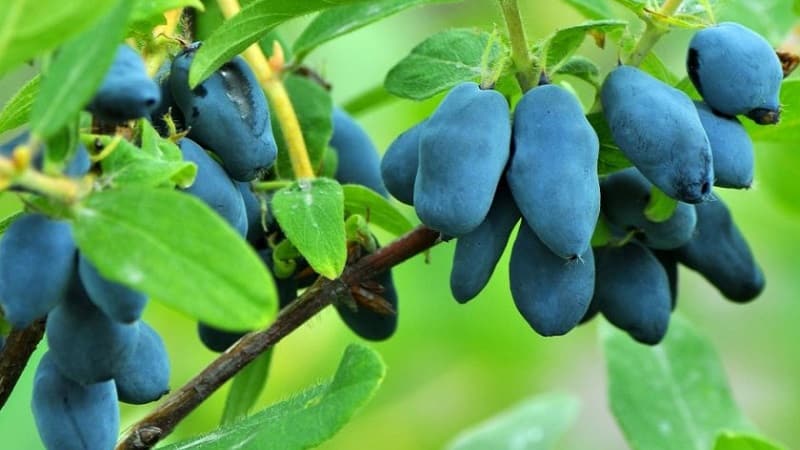
Characteristics of culture:
- bushes are vigorous, 1.7 m high and wide, the number of skeletal branches is insignificant;
- young shoots of green color without edge;
- leaves are dark green in color, cylindrical in shape, matte surface;
- the beginning of fruiting - 3 years after planting;
- the berries are spindle-shaped, the skin is dark purple with a thick waxy coating;
- fruit weight 2.6 g, length 1.3-1.5 cm;
- tasting taste score - 4.8 points;
- the taste is sweet and sour, without bitterness, reminiscent of the taste of blueberries and blueberries, the aroma is pronounced, the aftertaste is pleasant, sugar content is 8.9%;
- ripening period - second half of June;
- the berries hold tightly to the bush, ripen together, the dark color of the skin is a signal of the beginning of the harvest;
- dense skin ensures a high level of transportability;
- yield 2.5-5.5 kg;
- the best pollinating varieties: Bakcharsky giant, Strezhevchanka, Yugana, Silginka, Daughter of the giant.
The yield of the Vostorg variety increases with age: at the beginning of fruiting, about 1.3 kg is collected from the bush, at the age of 7-15 years the yield reaches 5.5 5 kg.
Silginka
Breeders from the Bakchar nursery worked on the creation of the Silginka variety. To obtain the variety, we used the varieties Turchaninova and Roxana. The culture was released in 1978 and is considered one of the first “cultivated” varieties.
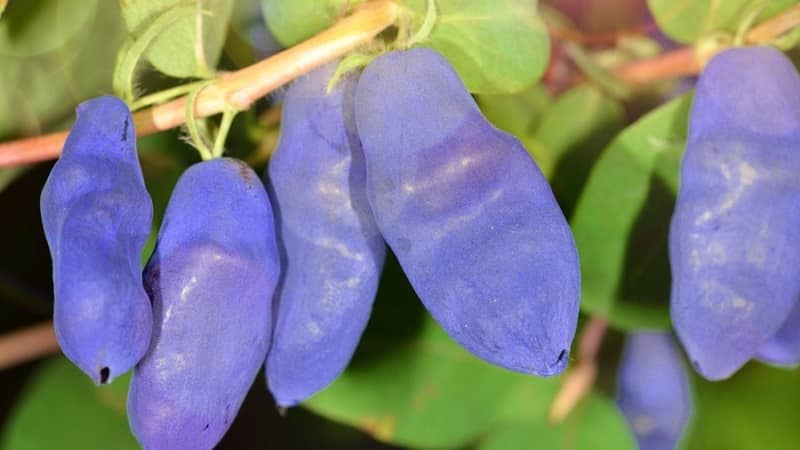
Characteristics of the variety:
- bushes are compact, medium-sized, 1.5 m high;
- young shoots are thin, curved, light green in color; as they mature, they acquire a darker color;
- the leaf blade is oval, slightly elongated, the base is concave;
- large fruits - 1.4-2.1 g, 2.5 cm long;
- the taste is pleasant, refreshing, sweet and sour without bitterness;
- the shape of the berries is cylindrical;
- the skin is thin, cannot be felt when eaten, has a dark blue or purple color with a waxy coating;
- the pulp is tender and juicy with a pleasant aroma;
- tasting taste score - 4.8 points;
- ripening is amicable, in mid-June;
- the beginning of fruiting - 3 years after planting;
- transportability is average;
- yield 1.5-3 kg per bush;
- pollinating varieties: Bakcharsky giant, Strezhevchanka, Yugana, Daughter of the giant.
Conclusion
Honeysuckle varieties Yubileinaya, Bakcharsky giant, Pride Bakchara, Tomichka, Yugana, Morena, Vostorg, Silginka are united under one name - Bakcharskaya.The cultivars have similar characteristics: self-sterility, requiring cross-pollination, early or mid-early ripening, sweet taste of berries with a slight sourness, tender pulp and dark purple skin, high resistance to frost, diseases and insects. Productivity is average or high depending on the variety; berry picking begins in June.